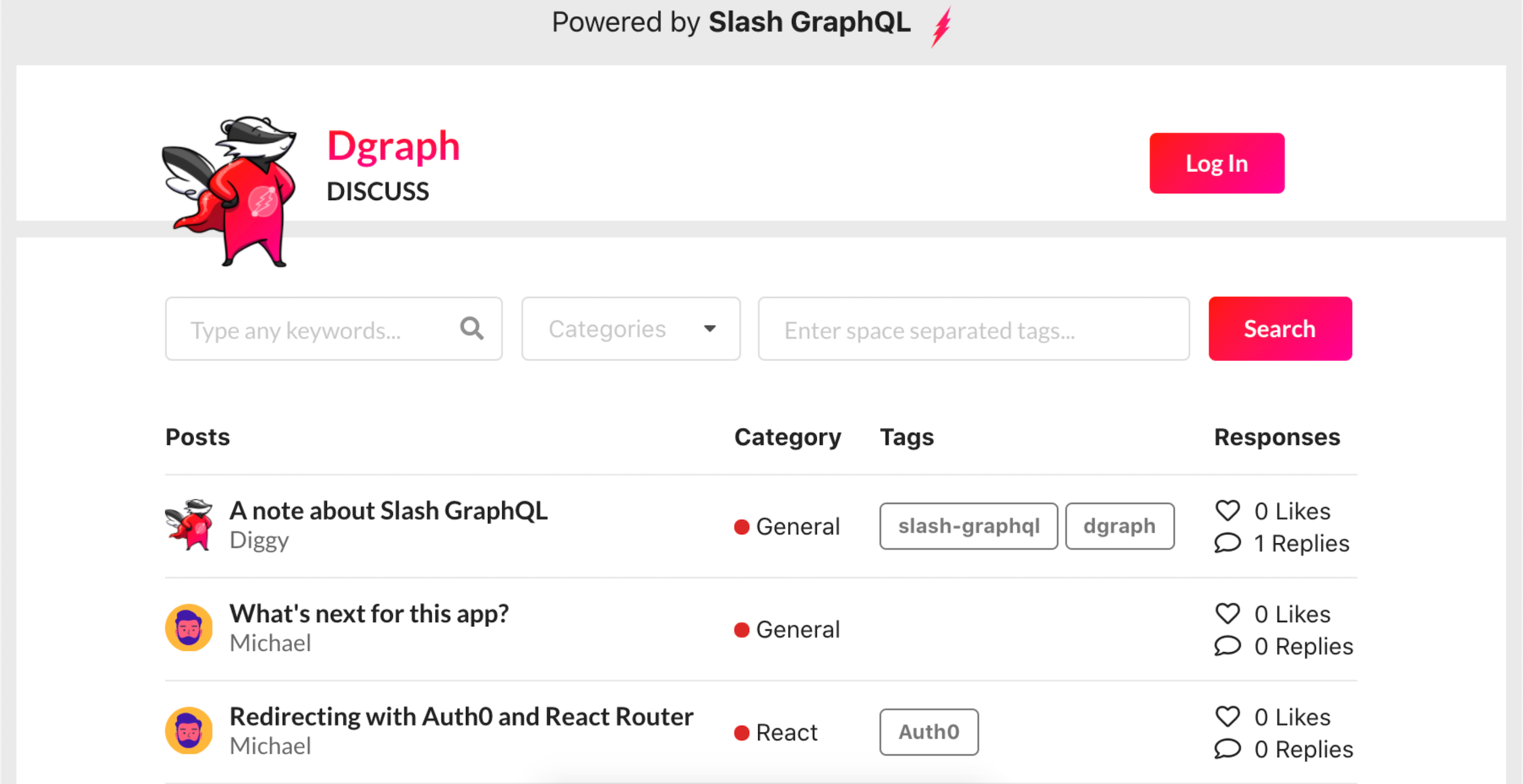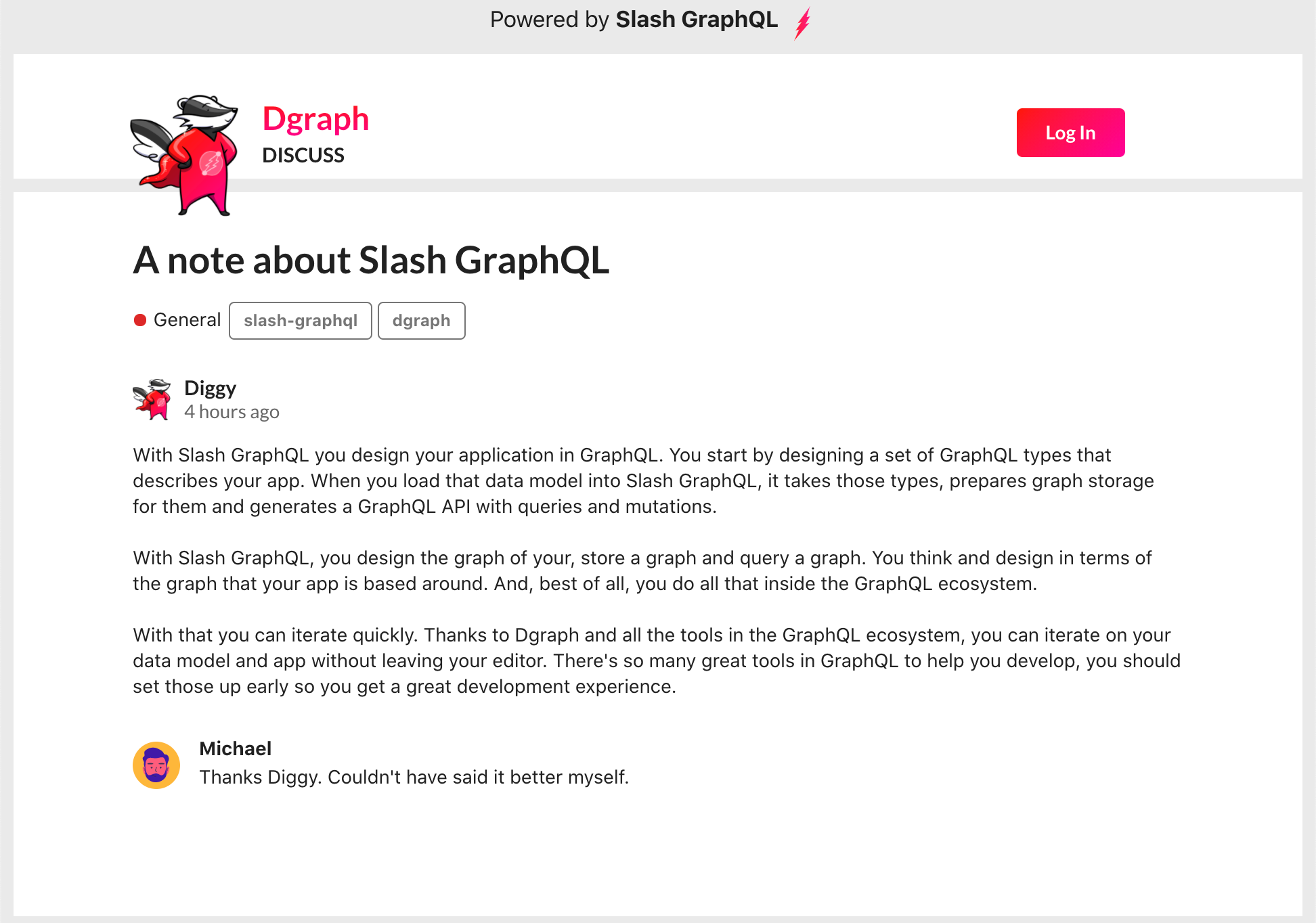Introduction
This tutorial walks you through building a reasonably complete message board app. We selected this app because it’s familiar and easy enough to grasp the schema at a glance, but also extensible enough to add things like integrated authorization and real-time updates with subscriptions.
The App
This app is designed to manage lists of posts in in different categories. A home page lets each user view a feed of posts, as follows:

message board app main page
This app will use Dgraph Cloud’s built-in authorization to allow public posts that anyone can see (even without logging in) but restrict posting messages to users who are logged-in. We’ll also make some categories private, hiding them from any users who haven’t been granted viewer permissions. Users who are logged-in can create new posts, and each post can have a stream of comments from other users. A post is rendered on its own page, as follows:

App post page
This app will be completely serverless app:
- Dgraph Cloud provides the “backend”: a Dgraph database in a fully-managed environment
- Auth0 provides serverless authentication
- Netlify is used to deploy the app UI (the “frontend”)
Why use GraphQL?
You can build an app using any number of technologies, so why is GraphQL a good choice for this app?
GraphQL is a good choice in many situations, but particularly where the app data is inherently a graph (a network of data nodes) and where GraphQL queries let us reduce the complexity of the UI code.
In this case, both are true. The data for the app is itself a graph; it’s
about users, posts and comments, and the links between them. You’ll naturally
want to explore that data graph as you work with the app, so GraphQL makes a
great choice. Also, in rendering the UI, GraphQL removes some complexity for
you.
If you built this app with REST APIs, for example, our clients (i.e., Web and
mobile) will have to programmatically manage getting all the data to render a
page. So, to render a post using a REST API, you will probably need to access
the /post/{id} endpoint to get the post itself, then the
/comment?postid={id} endpoint to get the comments, and then (iteratively for
each comment) access the /author/{id} endpoint. You would have to collect the
data from those endpoints, discard extra data, and then build a data structure
to render the UI. This approach requires different code in each version of the
app, and increases the engineering effort required and the opportunity for bugs
to occur in our app.
With GraphQL, rendering a page is much simpler. You can run a single GraphQL query that gets all of the data for a post (its comments and the authors of those comments) and then simply lay out the page from the returned JSON. GraphQL gives you a query language to explore the app’s data graph, instead of having to write code to build the data structure that you need from a series of REST API calls.
Why Dgraph Cloud?
Dgraph Cloud lets you build a GraphQL API for your app with just a GraphQL schema, and it gets you to a running GraphQL API faster than any other tool.
Often, a hybrid model is used where a GraphQL API is layered over a REST API or over a document or relational database. So, in those cases, the GraphQL layer sits over other data sources and issues many queries to translate the REST or relational data into something that looks like a graph. There’s a cognitive jump there, because your app is about a graph, but you need to design a relational schema and work out how that translates into a graph. So, you’ll think about the app in terms of the graph data model, but always have to mentally translate back and forth between the relational and graph models. This translation presents engineering challenges, as well as an impact to query efficiency.
You don’t have any of these engineering challenges with Dgraph Cloud.
Dgraph Cloud provides a fully-managed Dgraph database that stores all data natively as a graph; it’s a database of nodes and edges, with no relational database running in the background. Compared to a hybrid model, Dgraph lets you efficiently store, query and traverse data as a graph. Your data will get stored just like you design it in the schema, and app queries are a single graph query that fetches data in a format that can be readily consumed by your app.
With Dgraph Cloud, you design your application in GraphQL. You design a set of GraphQL types that describes your requirements. Dgraph Cloud takes those types, prepares graph storage for them, and generates a GraphQL API with queries and mutations.
So, you can design a graph, store a graph and query a graph. You think and design in terms of the graph that your app needs.
What’s next
First, you will deploy a running Dgraph Cloud backend that will host our GraphQL API. This gives you a working backend that you can use to build out your app.
Then you will move on to the design process - it’s graph-first, in fact, it’s GraphQL-first. After you design the GraphQL types that our app is based around, Dgraph Cloud provides a GraphQL API for those types; then, you can move straight to building your app around your GraphQL APIs.